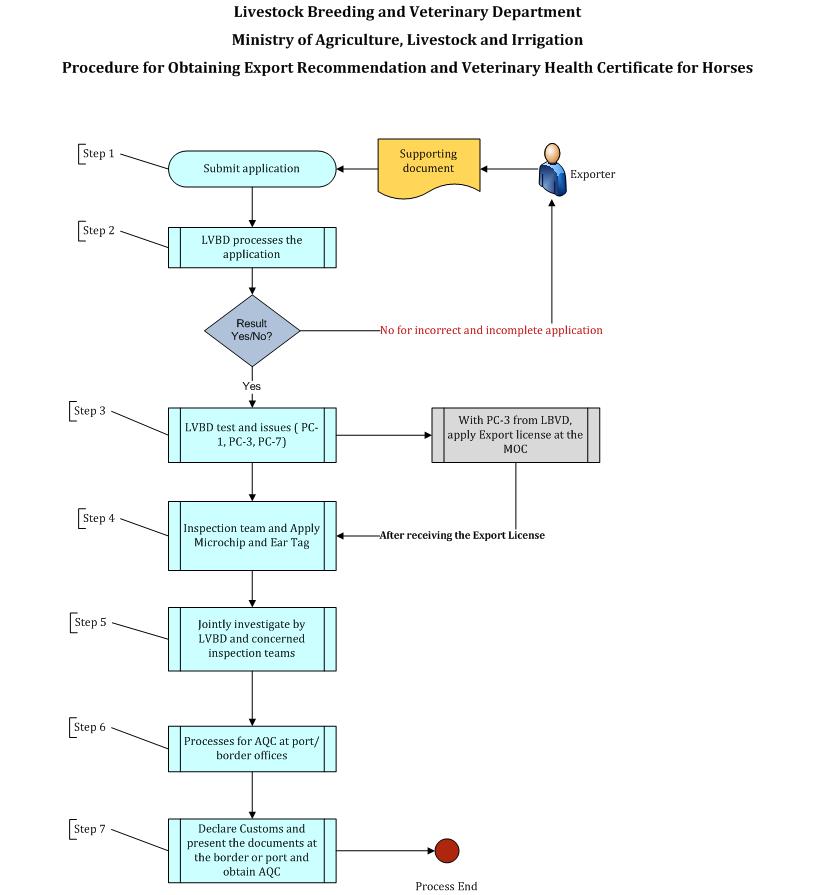Procedure for Obtaining Export Recommendation and Veterinary Health Certificate for exportation of Cattle, Buffalo & Horses
| Category | Export |
| Picture |

|
| Summary | Procedure for Obtaining Export Recommendation and Veterinary Health Certificate for exportation of Cattle, Buffalo & Horses issued by Livestock Breeding and Veterinary Department of the Ministry of Agriculture, Livestock and Irrigation |
| Description | Livestock Breeding and Veterinary Department Ministry of Agriculture, Livestock and Irrigation Procedure for Export Recommendation and Veterinary Health Certificate for exportation of Cattle, Buffalo & Horses Step (1) Exporter shall apply Export Recommendation (ER) and Veterinary Health Certificate (VHC) along with supporting documents to the Livestock Breeding and Veterinary Department (LBVD). The exporter first submits the application along with following supporting documents for Veterinary Health Certificate.
Step (2) LVBD reviews and processes the application. For incomplete and incorrect application, the LBVD informs exporter with reason. If application is rejected, the process ends here. For the complete and correct application, the LBVD informs the exporter for the animal health test. Step (3) LBVD conducts the animal health test. For the live animals that purchased in the district area, the exporter must inform LBVD’s district authority for animal health test. The LBVD office in district after giving an injection of the vaccine to the livestock, will issue the Animal Health and Development/ Prevention & Control Form -1) (AHD/PC-1). For the successful health test, the LBVD issues the veterinary health certificate called Animal Health and Development/ Prevention & Control Form-3 (AHD/ PC-3). For the exporter who buys the livestock from livestock breeding farms, must submit a copy of livestock farms registration certificate (Animal Health and Development/ Prevention & Control Form-7) (AHD/PC-7), and the recommendation from village head and an original sales contract of purchasing livestock to prove the ownership of the livestock. The list of the recommendations that required to obtain are-
Step (4) The exporter who received the Form 3 shall continue to apply export license at the MOC and transport the animals from the district to the temporary livestock collecting farms. Then, the LBVD conducts field inspection and marks the livestock with microchip/ear-tag. The exporter shall pay the fees for Micro Chip/Ear-Tag and livestock vaccine injection. Based on the field inspection result, the LBVD head office shall issue the recommendation letter and Veterinary Health Certificate. Step 5 LVBD officials and concerned inspection team shall jointly conduct the inspection along the respective checkpoints. The checkpoints locations are as follow.
Step 6 Livestock exporter must apply Animal Quarantine Certificate at the respective Animal Quarantine Station (AQS) at the port or border trading zone. The LBVD checks the registered livestock by using the scanner to scan the Ear-Tag or Micro Chip. For the livestock that are clear with disease, the LBVD issues the Animal Quarantine Certificate for exportation. The exporter must pay the necessary fees during the inspection process. Step 7
Remark
|
Forms
The following form/s are used in this procedure.
| Title | Description | Category | Agency |
|---|
